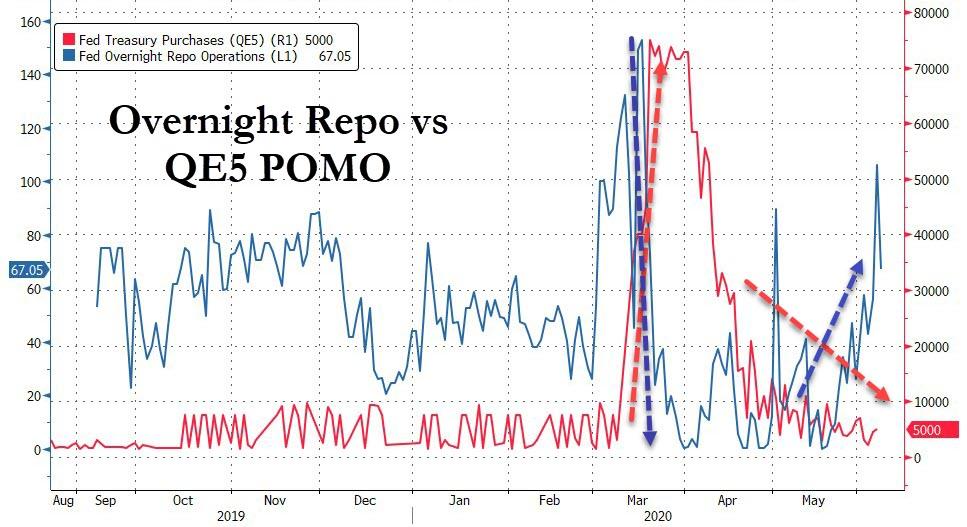Fed Overnight Repos Continue To Rise As QE Shrinks
Tyler Durden
Mon, 06/08/2020 – 10:09
After barely seeing any utilization for much of April and May after the Fed launched Unlimited QE, in the past three weeks there has been a clear rising trend in usage of the Fed’s overnight (and term) repo operations, which on Friday rose to the highest since the March crisis, hitting $106.25BN alongside a $53.2BN in 20 day repos, and earlier on Monday saw another $67.05BN in overnight repo (across both TSYs and MBS). While there is some debate about the cause for this apparent tightening in financial conditions, the simplest explanation is that as the Fed continues to shrink its daily POMO, which this week averages just $4.5 BN per day, dealers have to find other means to extract liquidity and are increasingly turning to the Fed’s repo operations.
The question here is whether the Fed has shrunk its QE to a point that is unsustainable in light of surging treasury supply, which as a reminder, should amount to trillions more in the near term. One place where this theory has validation is in long-term yields, which spiked late last week, and sharply steepened the yield curve.
Commenting on this, JPM’s Nikolaos Panigirtzoglou said that “steepening of the U.S. Treasury curve reflects to a significant extent high (bond) supply versus QE.” He then echoed a warning we posted some time ago, namely that “the Fed at $4-5 billion QE a day is not doing enough to offset supply. It would become more challenging for the Fed if the 10-year…yield approaches 1%.“
Of course, at that point the Fed can simply launch Yield Curve Control to make sure the Fed does not lose control, although according to a WSJ article over the weekend from the Fed’s current “whisperer” Nick Timiraos, “Fed officials aren’t prepared to announce any decision on so-called yield caps when their two-day policy meeting concludes Wednesday.” Perhaps, but that may change fast should the blow out in yields accelerate and the 10Y rise above 1%.
Meanwhile, as Wrightson ICAP economist Lou Crandall writes, when the Federal Reserve announces the next repo operations schedule this week, it’s unlikely it will make “any significant changes,” as Powell has repeatedly said that the Fed is in no hurry to “normalize” its operations, and the April minutes put the market on notice that the terms of the Desk’s repo funding would probably become less generous over time.
According to Crandall, it’s also unlikely the Fed sees any near-term need to push repo rates higher as the cumulative effect of the Treasury’s bill issuance in April and May has begun to push overnight rates higher this month and the “prospect of large seasonal outflows” from money funds during the delayed tax season in July could create additional pressures next month. Also of note, the ICAP strategist notes that the Fed has been “quietly” scaling back its repo market footprint by shortening tenors and reducing the frequency of its term operations.
Putting all this together, between the shrinking amount of weekly QE and the Fed’s scaling back of the repo market, it is distinctly possible that we may soon get a rate tantrum as bond traders realize that there is not enough organic demand to prefund the trillions in budget deficits over the horizon, and that another market “intervention” will be needed by the Fed to restore the generous liquidity conditions from March/April with the US continuing to spend like a drunken sailor.
